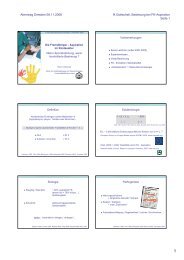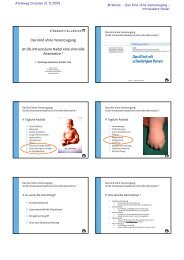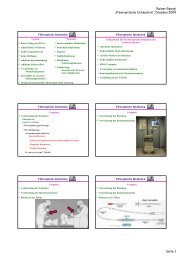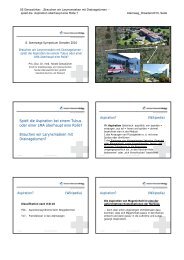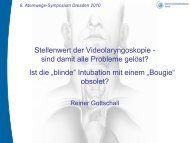Folie 1 - Atemweg Uniklinikum Dresden
Folie 1 - Atemweg Uniklinikum Dresden
Folie 1 - Atemweg Uniklinikum Dresden
Erfolgreiche ePaper selbst erstellen
Machen Sie aus Ihren PDF Publikationen ein blätterbares Flipbook mit unserer einzigartigen Google optimierten e-Paper Software.
7. <strong>Atemweg</strong>s-Symposium <strong>Dresden</strong>, 21. November 2009<br />
Die Intubation bei schwierigem <strong>Atemweg</strong> –<br />
sind Alternativen zum „Goldstandard“ hilfreich?<br />
(Bonfils, Airtraq, Videolaryngoskope)<br />
Klinik für Anästhesiologie und Intensivtherapie<br />
R. Gottschall<br />
Reiner Gottschall<br />
Garcia M Observations of the human voice. Proc Royal Soc 1855;7/13<br />
Türck L Kehlkopfspiegel und die Methode seines Gebrauchs. Z Ges Ärzte zu Wien 1858;26<br />
Czermak JN Über den Kehlkopfspiegel. Wien Med Wschr 1858;13 u.16<br />
Klinik für Anästhesiologie und Intensivtherapie<br />
R. Gottschall<br />
Indirekte Laryngoskopie<br />
„Goldstandard“ Macintosh - Laryngoskop<br />
Macintosh RR A new laryngoscope. Lancet 1943;1:205<br />
McIntyre JWR Laryngoscope design and difficult adult tracheal intubation.<br />
Can J Anaesth 1989;36:94-8<br />
Scott J, Baker PA How did the Macintosh laryngoscope become so popular?<br />
Pediatr Anesth 2009;19:24-9<br />
3<br />
5<br />
Klinik für Anästhesiologie und Intensivtherapie<br />
R. Gottschall<br />
„To date there is no technique found to be effective in<br />
every case or that can solve all airway problems“<br />
Klinik für Anästhesiologie und Intensivtherapie<br />
R. Gottschall<br />
Direkte Laryngoskopie<br />
Kirstein A Autoskopie des Larynx und der Trachea (Besichtigung ohne Spiegel).<br />
Berl klin Wschr 1895;22:476-8<br />
Klinik für Anästhesiologie und Intensivtherapie<br />
R. Gottschall<br />
FE Agrò, Rom 2009<br />
Intubation mit Macintosh - Laryngoskop: Lernkurve<br />
Macintosh Gr. 3+4; Magill -Tuben<br />
→ 57 Intubationen für Erfolgsquote von 90%<br />
Konrad C et al. Learning manual skills in anesthesiology: is there a recommended number of<br />
cases for anesthetic procedures? Anesth Analg;1998:635-9<br />
2<br />
4<br />
6
Klinik für Anästhesiologie und Intensivtherapie<br />
R. Gottschall<br />
Ist eine schwierige direkte Laryngoskopie vorhersagbar?<br />
Test Sensitivität Spezifität<br />
Mundöffnung 0.26 0.94<br />
PATIL 0.65 0.81<br />
Uk -Protrusion 0.29 0.85<br />
Ao -Extension ? ?<br />
MALLAMPATI 0.4-0.67 0.52-0.84<br />
→ Inzidenz von C&L ≥ III 10-11%<br />
Rose DK et al. Can J Anesth 1996;43:30-4<br />
Adnet F et al. Anesthesiology 2001;95:836-41<br />
Rosenblatt WH ASA Refresher Courses in Anesthesiology 2008<br />
Klinik für Anästhesiologie und Intensivtherapie<br />
R. Gottschall<br />
Flexible Wachintubation: Indikationen<br />
□ Erwartet schwieriger <strong>Atemweg</strong> (strukturell, funktionell)<br />
□ Erhalt der Spontanatmung<br />
□ Aspirationsrisiko<br />
□ Neurologische Beurteilung<br />
□ Prävention von Intubationsschäden<br />
□ Extreme Patientenposition<br />
□ Ausbildung, Training<br />
Rosenblatt WH J Clin Anesth 2004;16:312-16<br />
Langeron O et al. Critical Care 2008;10:243-7<br />
Boet S et al. Can J Anesth 2009;56:87-8<br />
Klinik für Anästhesiologie und Intensivtherapie<br />
R. Gottschall<br />
Canis domesticus →<br />
hier geht‘s leicht…!<br />
Intubation mittels flexibler Fiberoptik: Lernkurve<br />
□ Theoretische Kenntnisse und praktische Übungen an Modellen<br />
→ mehrere Stunden…<br />
□ Patienten mit normalem <strong>Atemweg</strong>:<br />
Wachintubation und Intubation in Narkose je 15-20x<br />
□ Patienten mit schwierigem <strong>Atemweg</strong>:<br />
Expertise = mehr als 100 Anwendungen bei diversen<br />
Indikationen (Wachintubation, DLT-Position, etc)<br />
Wheeler M, Ovassapian A Fiberoptic endoscopy-aided techniques.<br />
In: Hagberg CA (ed) Benumof´s Airway Management, 2nd edition, Mosby Elsevier,<br />
Philadelphia 2007, p 399-438<br />
7<br />
9<br />
11<br />
Klinik für Anästhesiologie und Intensivtherapie<br />
R. Gottschall<br />
„Goldstandard“ flexibles Fiberbronchoskop<br />
Murphy P<br />
A fibre-optic endoscope used for nasal intubation.<br />
Anaesthesia 1967;22:489-91<br />
Kronschwitz H<br />
Die nasotracheale Intubation mit einem Intubations-Fiberskop.<br />
Der Anaesthesist 1969;18:58-9<br />
Klinik für Anästhesiologie und Intensivtherapie<br />
R. Gottschall<br />
Flexible Wachintubation: Nachteile<br />
□ Erwartet schwieriger <strong>Atemweg</strong> (strukturell, funktionell)<br />
□ Erhalt der Spontanatmung<br />
□ Aspirationsrisiko<br />
□ Neurologische Beurteilung<br />
□ Prävention von Intubationsschäden<br />
□ Extreme Patientenposition<br />
□ Ausbildung, Training<br />
■ Laryngeale Tubuspassage „blind“<br />
■ Komplexität: Handhabung (Lernkurve↓, Assistenz), Zeitaufwand,…<br />
Rosenblatt WH J Clin Anesth 2004;16:312-16<br />
Langeron O et al. Critical Care 2008;10:243-7<br />
Boet S et al. Can J Anesth 2009;56:87-8<br />
Klinik für Anästhesiologie und Intensivtherapie<br />
R. Gottschall<br />
Macht „um die Ecke schauen“ Sinn?<br />
□ Anpassung an die Anatomie (…macht immer Sinn)<br />
□ Anpassung an veränderte Anatomie ist schon schwieriger<br />
□ „Blinde“ Verfahren sollten der Vergangenheit angehören<br />
□ Optische Hilfsmittel sind medizinischer Standard!<br />
□ Der vergleichende Nutzen neuer Hilfsmittel ist jedoch…<br />
(schwierig) zu belegen<br />
Mihai R et al. A quantitative review and meta-analysis of performance of non-standard<br />
laryngoscopes and rigid fibreoptic intubation aids. Anaesthesia 2008;63:745-0<br />
Frerk CM, Lee G Laryngoscopy: time to change our view. Anaesthesia 2009;64:351-7<br />
8<br />
10<br />
12
Klinik für Anästhesiologie und Intensivtherapie<br />
R. Gottschall<br />
www.medber.de<br />
Klinik für Anästhesiologie und Intensivtherapie<br />
R. Gottschall<br />
„Keiner ist blinder als der,<br />
der nicht sehen will“<br />
Johnathan Swift 1667-1745<br />
Starre indirekte Laryngoskope und optische Stilette<br />
□ Starre indirekte Laryngoskope mit optischer Assistenz (―)<br />
■ Starre (und halbstarre) fiberoptische Stilette (Mandrins)<br />
→ z.B. RIF n. Bonfils ®<br />
■ Starre indirekte fiberoptische Laryngoskope (Video-Option)<br />
→ z.B. Airtraq ®<br />
■ Video -assistierte starre (und halbstarre) Instrumente<br />
→ Videolaryngoskope (z.B. DCI-VLS ® )<br />
Law JA, Hagberg CA The evolution of upper airway retraction: new and old<br />
laryngoscope blades.<br />
In: Hagberg CA (ed) Benumof´s Airway Management, 2nd edition, Mosby Elsevier,<br />
Philadelphia 2007, p 532-75<br />
Klinik für Anästhesiologie und Intensivtherapie<br />
R. Gottschall<br />
Bonfils ® : Einführtechniken<br />
□ Laryngoskop / Zungenspatel<br />
□ UK -Zungen -Handgriff<br />
□ Esmarch -Handgriff<br />
Pharyngealen Raum<br />
schaffen…<br />
Halligan M, Charters P Anaesthesia 2003;58:1087-91<br />
13<br />
15<br />
17<br />
Klinik für Anästhesiologie und Intensivtherapie<br />
R. Gottschall<br />
Eine Illusion: Das ideale Laryngoskop<br />
□ Verfügbarkeit<br />
□ Technische Daten<br />
□ Trainingsoptionen<br />
□ Handhabung<br />
□ Traumapotenzial<br />
□ Zugangsoption<br />
□ Multifunktion<br />
□ Portabilität<br />
■ Lernkurve<br />
■ Zielgruppe (Pat.)<br />
■ Mitbeobachtung<br />
□ Bilddokumentation<br />
□ Misserfolgsrate<br />
□ Wachintubation<br />
□ Ad hoc -Einsatz<br />
□ Wiedereinsetzbarkeit<br />
□ Kindergrößen<br />
□ Daten, Evidenz<br />
■ Invest-, Folgekosten<br />
■ Präferenzen<br />
Erweitert n. Gottschall R Laryngoskopie nach Bullard, Bonfils und „Notrohr“. 2006/2<br />
www.anaesthesie-cme.de<br />
Klinik für Anästhesiologie und Intensivtherapie<br />
R. Gottschall<br />
40°<br />
Retromolares IntubationsFiberskop n. Bonfils ®<br />
O 2<br />
www.karlstorz.de<br />
Rudolph & Schlender: Anaesthesiol Reanimat 1996;21:127-0<br />
Rudolph C et al Minerva Anestesiol 2007;73:567-74<br />
Mihai R et al. Anaesthesia 2008;63:745-0<br />
Klinik für Anästhesiologie und Intensivtherapie<br />
R. Gottschall<br />
Videoclip<br />
Videoclip<br />
Retromolares IntubationsFiberskop n. Bonfils ®<br />
□ Hochwertige Optik (110°)<br />
□ Oraler Zugang variabel<br />
□ O2 -Anschluß<br />
□ Tracheostoma -Management<br />
□ Kosten↓ (im Vergleich)<br />
□ PDT -Monitoring*<br />
*Buehner U et al. Anaesthesia 2006;61:665-0<br />
14<br />
16<br />
18
Klinik für Anästhesiologie und Intensivtherapie<br />
R. Gottschall<br />
Variante n. Brambrink<br />
Bonfils ® : Kindervarianten<br />
2.0 mm Ø / L 22 cm → ETT 2.5-3.5 ID<br />
3.5 mm Ø / L 35 cm → ETT 4.0-5.5 ID<br />
Klinik für Anästhesiologie und Intensivtherapie<br />
R. Gottschall<br />
Airtraq ® : Optisches Einweg - Laryngoskop<br />
Klinik für Anästhesiologie und Intensivtherapie<br />
R. Gottschall<br />
Airtraq ® : Optisches Einweg - Laryngoskop<br />
□ Einweginstrument<br />
□ Einsetzbarkeit
Klinik für Anästhesiologie und Intensivtherapie<br />
R. Gottschall<br />
Video - Laryngoskope<br />
www.karlstorz.de www.ifm-leiche.de www.saegeling-mt.de<br />
www.surgcomp.com www.ambu.de<br />
Kaplan MB et al. Seeing is believing: the importance of video laryngoscopy in teaching<br />
and in the managing the difficult airway. Surg Endosc 2006;Suppl 2:S479-83<br />
Klinik für Anästhesiologie und Intensivtherapie<br />
R. Gottschall<br />
Video - Laryngoskopie<br />
□ Methodische Ausbildung der Laryngoskopie<br />
→ Supervision, Lernkurve steil<br />
□ Intubationsbedingungen verbessert<br />
→ um 41.5% bessere Visualisierung<br />
□ Empfehlung für schwieriges <strong>Atemweg</strong>smanagement<br />
Kaplan MB et al.<br />
Comparison of direct and video-assisted views of the larynx during routine intubation.<br />
J Clin Anesth 2006;18:357-62<br />
Klinik für Anästhesiologie und Intensivtherapie<br />
R. Gottschall<br />
Video - Laryngoskope: Krafteinwirkung maxillär<br />
□ Macintosh vs. Miller n=58<br />
→ Kraftspitzen bei 56 N (x − 38 ±2 N)<br />
→ Variabilität v.a. zwischen verschiedenen Akteuren<br />
→ Miller: resultierende Kraft und Kopfextension 30%↓<br />
Hastings RH et al. Anesth Analg 1996;82:456-61+462-8<br />
□ Macintosh vs. DCI-VLS n=44<br />
→ Macintosh: 0 -87.4 N (Median 15.3 N)<br />
→ DCI-VLS: 0 -45.2 N (Median 2.1 N)<br />
→ Mallampati + C&L nicht prädiktiv für resultierende Kraft<br />
Lee RA et al. Anesth Analg 2009;108:187-91<br />
25<br />
27<br />
29<br />
Klinik für Anästhesiologie und Intensivtherapie<br />
R. Gottschall<br />
Video - Laryngoskopie<br />
□ Blickwinkel ca 15° 15 → 60° 60<br />
□ + Zoom -Effekt<br />
□ Direkte + indirekte Sicht<br />
□ Kombination mit Einführhilfen<br />
□ DLT -Intubation<br />
□ Teaching optimiert<br />
Dörges V, Serocki G Blick um die Ecke. Notfall- und Intensivmedizin 2009;5:24-6<br />
Klinik für Anästhesiologie und Intensivtherapie<br />
R. Gottschall<br />
Video - Laryngoskopie: schwieriger <strong>Atemweg</strong><br />
Maharaj CH et al. Evaluation of the Airtraq ® and Macintosh laryngoscopes in patients at increased<br />
risk for difficult tracheal intubation. Anaesthesia 2008;63:182-8<br />
Stroumpoulis K et al. Videolaryngoscopy in the management of the difficult airway: a comparison<br />
with the Macintosh blade. Eur J Anaesthesiol 2009;26:218-22<br />
Jungbauer A et al. Expexted difficult tracheal intubation: a prospective comparison of direct<br />
laryngoscopy and video laryngoscopy in 200 patients. Br J Anaesth 2009;102:546-0<br />
Serocki G et al. Management of the predicted difficult airway: a comparison of conventional blade<br />
laryngoscopy with video-assisted blade laryngoscopy and the GlideScope.<br />
Eur J Anaesth 2009;26:730-5<br />
Malin E et al. Performance of the Airtraq ® laryngoscope after failed conventional tracheal<br />
intubation: a case series. Acta Anaesthesiol Scand 2009;53:858-63<br />
Asai T et al. Use of the Pentax-AWS ® in 293 patients with difficult airways.<br />
Anesthesiology 2009;110:898-904<br />
→ C&L -Score besser<br />
→ Erfolgsrate (Intubation) höher<br />
→ Zeitaufwand (Intubation) geringer<br />
→ Erfordernis von Zusatzmanövern (z.B. BURP) geringer<br />
→ Hämodynamische Stabilität besser<br />
Klinik für Anästhesiologie und Intensivtherapie<br />
R. Gottschall<br />
Video - assistierte Intubation: Adipositas permagna<br />
□ Macintosh vs. Airtraq n=106 BMI ≥ 35 kg/m 2<br />
→ Intubationszeit↓, Prävention von O 2 -Ensättigungen<br />
Ndoko SK et al. Br J Anaesth 2008;100:263-8<br />
□ Macintosh vs. Video Intubation Unit ® n=40 BMI ≥ 35 kg/m 2<br />
→ C&L / Intubationsbedingungen signifikant verbessert<br />
Bathory I et al. Acta Anaesthesiol Scand 2009 (in press)<br />
26<br />
28<br />
30
Klinik für Anästhesiologie und Intensivtherapie<br />
R. Gottschall<br />
Video - assistierte Intubation: Adipositas permagna<br />
□ Macintosh vs. LMA CTrach ® und Airtraq n=318 BMI ≥ 35 kg/m 2<br />
→ LMA CTrach: kürzeste Apnoezeit<br />
→ Airtraq: kürzeste Intubationszeit<br />
→ Serielle O 2 -Entsättigungen vermieden<br />
Dhonneur G et al. Obes Surg 2009;19:1096-101<br />
□ Macintosh vs. DCI-VLS, GlideScope oder McGrath n=150<br />
→ C&L↑, Intubationszeit↓, Intubationsversuche↓,<br />
Erfordernis von Hilfsmitteln (Mandrin, BURP)↓<br />
Maassen R et al. Anesth Analg 2009;109:1560-5<br />
Klinik für Anästhesiologie und Intensivtherapie<br />
R. Gottschall<br />
Simulation instabile / dysfunktionelle HWS<br />
□ HWS -Bewegung drei-dimensional<br />
Macintosh vs. Bullard, Bonfils und ILMA n=48<br />
→ HWS -Bewegung↓: Bullard, ILMA, Bonfils, Macintosh<br />
→ Intubationszeiten↓: Bullard, Macintosh, ILMA, Bonfils<br />
Wahlen & Gercek Eur J Anaesthesiol 2004;21:907-13<br />
□ HWS -Bewegung atlanto-occipital bis C4<br />
Macintosh vs. Bonfils n=20<br />
→ Ao -Distanz + HWS -Bewegung↓<br />
Rudolph C et al. Anaesthesia 2006;60:668-72<br />
Klinik für Anästhesiologie und Intensivtherapie<br />
R. Gottschall<br />
Starre indirekte Laryngoskope und optische Stilette:<br />
Wachintubation<br />
Videoclip<br />
Abramson SI et al. Awake insertion of the Bonfils retromolar intubation fiberscope in five patients with<br />
anticipated difficult airways. Anesth Analg 2008;106:1215-7<br />
Corbanese U, Possamai C Awake intubation with the Bonfils fibrescope in patients with difficult<br />
airway. Eur J Anaesth 2008;26:837-41<br />
Dimitriou VK et al. Awake tracheal intubation using the Airtraq 35<br />
® laryngoscope: a case series.<br />
Acta Anaesthesiol Scand 2009;53:964-7<br />
31<br />
33<br />
Klinik für Anästhesiologie und Intensivtherapie<br />
R. Gottschall<br />
Instabile / dysfunktionelle HWS<br />
□ Fiberoptische Wachintubation<br />
□ Manuelle in -line Stabilisierung AA / Rel.→ DL*<br />
■ Alternative Laryngoskope / starre Optiken<br />
□ Larynxmaske (Fastrach, Classic, ProSeal)<br />
□ Elektive Tracheotomie (LA)<br />
HWS Immobilisierung wesentlicher als Intubationstechnik,<br />
keine Einzeltechnik ist überlegen bzw. unproblematisch<br />
Manninen PJ et al. J Neurosurg Anesthesiol 2007;19:190-4<br />
Langford & Leslie J Clin Neuroscience 2009;16:366-72<br />
Bonhomme & Hans Curr Opin Anaesth 2009;22:579-85<br />
*Santoni BG et al. Anesthesiology 2009;110:24-31 - Manoach & Paladino p.6-7 (Editorial)<br />
Klinik für Anästhesiologie und Intensivtherapie<br />
R. Gottschall<br />
Simulation instabile / dysfunktionelle HWS<br />
□ Manuelle axiale in-line Stabilisierung Macintosh vs. Airtraq n=40<br />
→ Intubationszeit↓ Visualisierung↑ BURP↓<br />
→ Hämodynamische Stabilität besser<br />
Maharaj CH et al. Anesthesiology 2007;107:53-9<br />
□ HWS -Bewegung occipital bis C4 Macintosh vs. Airtraq n=20<br />
→ HWS -Bewegung↓ (29-44%)<br />
→ Anteriore Wk -Abweichung↓ (32-40%)<br />
Hirabayashi Y et al. Anaesthesia 2008;63:635-40<br />
□ HWS -Bewegung occipital bis Th1 Macintosh vs. Airtraq n=24<br />
→ Intubationszeiten identisch<br />
→ HWS -Bewegung um 66%↓ (außer C1/2 -Ebene)<br />
Turkstra TP et al. Anesthesiology 2009;111:97-101<br />
Klinik für Anästhesiologie und Intensivtherapie<br />
R. Gottschall<br />
Starre indirekte Laryngoskope und optische Stilette:<br />
Kinder<br />
□ Studien mit normalen <strong>Atemweg</strong>en (3 Mo. -17J)<br />
Macintosh vs. GlideScope Kim JT et al. Br J Anaesth 2008;101:531-4<br />
Macintosh vs. Bonfils Bein B et al. Pediatr Anesth 2008;18:1040-4<br />
Macintosh vs. DCI-VLS Mcnair D et al. Pediatr Anesth 2009;19:577-0<br />
Miller/Macintosh vs. DCI-VLS Vlatten A et al. Pediatr Anesth 2009;19:1102-7<br />
→ C&L stets verbessert<br />
→ 1. Intubationsversuch wenig erfolgreich<br />
→ Intubationszeiten verlängert…<br />
32<br />
34<br />
36
Klinik für Anästhesiologie und Intensivtherapie<br />
R. Gottschall<br />
Starre indirekte Laryngoskope und optische Stilette:<br />
Kinder<br />
□ Fallstudie mit erwartet schwierigem <strong>Atemweg</strong>: DCI-VLS<br />
→ 7 Säuglinge (3 -13 Mo.) mit div.Syndromen / schwieriger DL<br />
→ alle erfolgreich intubiert (alternativ zur flexiblen Fiberoptik!)<br />
Hackell RS et al. Anesth Analg 2009;109:763-6<br />
□ Fallberichte zum schwierigen <strong>Atemweg</strong> (diverse Instrumente…)<br />
□ Tipps… Airtraq → Xue FS et al. Pediatr Anesth 2009;19:916-8<br />
Bonfils → Xue FS et al. Pediatr Anesth 2009;19:419-21<br />
Klinik für Anästhesiologie und Intensivtherapie<br />
R. Gottschall<br />
Die Intubation bei schwierigem <strong>Atemweg</strong> – sind<br />
Alternativen zum „Goldstandard“ hilfreich?<br />
(Bonfils, Airtraq, Videolaryngoskope)<br />
…nach heutigem Erkenntnisstand (Datenlage)<br />
„Ja Ja“<br />
für die primäre oder sekundäre Laryngoskopie bei<br />
erwartet oder unerwartet schwierigem <strong>Atemweg</strong><br />
Erwachsener, die sicher oxygeniert werden können<br />
und bei denen eine (indizierte) laryngotracheale<br />
Tubuspassage möglich erscheint…<br />
Klinik für Anästhesiologie und Intensivtherapie<br />
R. Gottschall<br />
Fazit<br />
Alternative indirekte Laryngoskope und optische Stilette<br />
sind eine Bereicherung für problemorientiertes<br />
und atraumatisches <strong>Atemweg</strong>smanagement mit<br />
Potenzial für verbesserte Patientensicherheit!<br />
(Der Stellenwert im schwierigen <strong>Atemweg</strong>smanagement<br />
ist noch nicht abschließend geklärt!)<br />
37<br />
39<br />
41<br />
Klinik für Anästhesiologie und Intensivtherapie<br />
R. Gottschall<br />
Starre indirekte Laryngoskope und optische Stilette:<br />
Indikationsspektrum<br />
■ Unerwartet: Cormack & Lehane ≥ Grad 3 („can oxygenate“)<br />
□ Erwartet: - Alternative (Wach ( Wach-)Intubation )Intubation<br />
- HWS -Probleme<br />
- Limitierte Mund -Kiefer -Öffnung<br />
- Kritischer (maxillärer) Zahnstatus, etc<br />
□ Sonstige: - Infektionen (z.B. ( z.B. CJK → Airtraq) Airtraq<br />
- Habituelle Kieferluxation, Stimmberuf<br />
- Second look, Umintubation (Tubuswechselkatheter)<br />
- Training in Tagesroutine (außer Airtraq)<br />
- Bildgebung und -dokumentation<br />
dokumentation<br />
Klinik für Anästhesiologie und Intensivtherapie<br />
R. Gottschall<br />
…vorbehaltlich zu erwartender Daten (Evidenz!) sowie<br />
aktualisierter Empfehlungen (Leitlinien, Algorithmen).<br />
Die flexible Fiberoptik wird durch diese weniger komplex<br />
zu handhabenden Alternativen sinnvoll ergänzt, jedoch<br />
nicht ersetzt!<br />
Das Macintosh -Laryngoskop bekommt Konkurrenz,<br />
verliert langfristig (!) den Status (historischer Autorität) als<br />
„Goldstandard“…?<br />
Klinik für Anästhesiologie und Intensivtherapie<br />
R. Gottschall<br />
Starre indirekte Laryngoskope und optische Stilette:<br />
Ausbildung<br />
□ Video -assistierte Techniken verbessern die Erfolgsrate<br />
für die endotracheale Intubation und verringern die<br />
Rate von Fehlintubationen<br />
■ Video -assistierte Techniken werden als Bestandteil der<br />
Minimal -Kompetenz im Rahmen der Ausbildung für<br />
das erweiterte Airwaymanagement empfohlen<br />
Crosby E, Lane A<br />
Innovations in anesthesia education: the development and implementation<br />
of a resident rotation for advanced airway management.<br />
Can J Anesth 2009 (in press)<br />
38<br />
40<br />
42
Klinik für Anästhesiologie und Intensivtherapie<br />
R. Gottschall<br />
Starre indirekte Laryngoskope und optische Stilette:<br />
Übersichten<br />
Pott LM, Murray WB Review of video laryngoscopy and rigid<br />
fiberoptik laryngoscopy.<br />
Curr Opin Anaesth 2008;21:750-8<br />
Wasem S u. Mitarb. Videolaryngoskope für die endotracheale<br />
Intubation.<br />
AINS 2009;44:502-8<br />
Nagler J, Bachur RG Advanced airway management.<br />
Curr Opin Pediatr 2009;21:299-305<br />
Martin F, Buggy DJ (Editorial III) New airway equipment:<br />
opportunities for enhanced safety.<br />
Br J Anaesth 2009;102:734-8<br />
Agrò FE et al. New devices and techniques for airway management.<br />
Minerva Anestesiol 2009;75:141-9<br />
43<br />
Danke für f r Ihr Interesse!<br />
44




